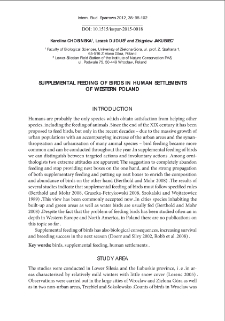Digital Library of Zielona Góra contains 9 272 digital objects
Object
Title: Supplemental feeding of birds in human settlements of western Poland
Group publication title:
Abstract:
Humans are probably the only species which obtain satisfaction from helping other species, including the feeding of animals. Since the end of the XIX century it has been proposed to feed birds, but only in the recent decades - due to the massive growth of urban populations with an accompanying increase of the urban areas and the synanthropisation and urbanisation of many animal species - bird feeding became more common and can be conducted throughout the year. ; In supplemental feeding of birds we can distinguish between targeted actions and involuntary actions. Among ornithologists two extreme attitudes are apparent: The suggestion to completely abandon feeding and stop providing nest boxes on the one hand, and the strong propagation of both supplementary feeding and putting up nest boxes to enrich the composition and abundance of birds on the other hand (Berthold and Mohr 2008). The results of several studies indicate that supplemental feeding of birds must follow specified rules (Berthold and Mohr 2008, Graszka-Petrykowski 2008, Szokalski and Wojtatowicz 1989). ; This view has been commonly accepted now. In cities species inhabiting the built-up and green areas as well as water birds are usually fed (Berthold and Mohr 2008). Despite the fact that the problem of feeding birds has been studied often an in depth in Western Europe and North America, in Poland there are no publications on this topic so far. Supplemental feeding of birds has also biological consequences, increasing survival and breeding success in the next season (Doerr and Silvy 2002, Robb et al. 2008).
Publisher:
Zielona Góra: University of Zielona Góra, Faculty of Biological Sciences
Format:
Resource Identifier:
DOI:
Pages:
Source:
International Studies on Sparrows, vol. 36
Language:
Rights:
Biblioteka Uniwersytetu Zielonogórskiego
Object collections:
- Repository > Faculties > Faculty of Biological Sciences
- Repository > Types of work > Articles
- Repository > Scientific journals and UZ publishing series > International Studies on Sparrows
Last modified:
May 23, 2023
In our library since:
May 5, 2023
Number of object content hits:
177
All available object's versions:
https://zbc.uz.zgora.pl/repozytorium/publication/81580
Show description in RDF format:
Show description in OAI-PMH format:
| Edition name | Date |
|---|---|
| Supplemental feeding of birds in human settlements of western Poland | May 23, 2023 |

